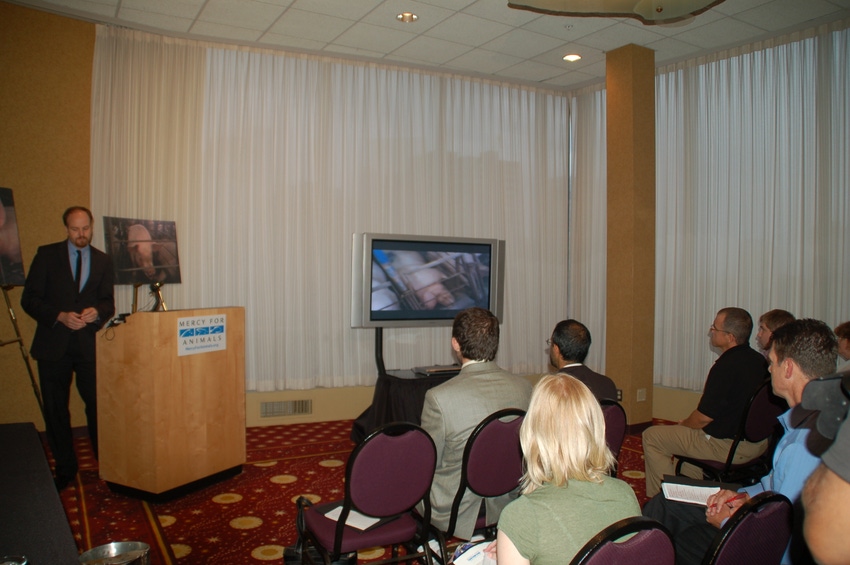In July, the animal rights group Mercy for Animals (MFA) released an undercover video shot at one of Christensen Farms' facilities in an effort to pressure retail outlets to denounce the use of gestation stalls by their pork suppliers. In the aftermath, Christensen Farms’ Chief Financial Officer (CFO) Glenn Stolt offers some crisis management tips to fellow pork producers.

As one of the country’s largest pork producers, Christensen Farms, headquartered near Sleepy Eye, MN, has a long-standing policy of prioritizing animal welfare and planning for the unexpected.
In July, the animal rights group Mercy for Animals (MFA) released an undercover video shot at one of the company’s farms in an effort to pressure retail outlets to denounce the use of gestation stalls by their pork suppliers.
In the aftermath, Christensen Farms’ Chief Financial Officer (CFO) Glenn Stolt offered some crisis management tips to fellow pork producers.
“First and foremost, whether a crisis happens or not, it is crucial that everyone across the pork industry have an established animal welfare policy that is both conveyed and thoroughly incorporated into employee training programs,” he says. “We have a zero-tolerance approach in our animal welfare policy. Employees sign a statement saying that seeing and not reporting animal abuse is grounds for immediate termination, just as if they had committed the abuse themselves.”
In addition, farms must have a clearly understood crisis management plan to cover any emergency. “It is not unlike other plans covering everything from employee injury to an unexpected power outage. You need to be prepared,” he states. “The plan needs to be nimble enough to adapt to circumstances in a very short period of time. I mean hours, not days.”
Christensen Farms’ response was to pull key people together to clarify roles and establish a crisis management team. People were selected to deliver information to contractors, packers, retailers, customers, industry organizations and the media.
“We started with gathering the facts and we followed the rule of telling the story early, telling it often and telling it ourselves,” Stolt explains. “We worked to keep our message honest and consistent among our constituents.”
Internal Actions
When the video was obtained, an internal investigation was launched and an independent academic expert was sought to conduct a third-party audit. Stolt says some practices were depicted out of context and would likely be disturbing to those unfamiliar with production agriculture.
Christensen Farms’ perspective of the video was shared with industry organizations and staff from the Minnesota Pork Producers Association, who provided an industry perspective during interviews. A public relations firm helped craft a response.
At a July 19 press conference in Minneapolis, MFA director of investigations Matt Rice claimed the video footage was shot between December 2011 and March 2012. The main reason for revealing the undercover video nearly five months after it was recorded was to pressure Walmart.
“We’ve been talking to Costco, K-Mart and Walmart for months,” he says. “It was only after months of foot-dragging that we decided to go public. We have been talking to customers of Christensen Farms for months and Walmart was the last holdout. If Walmart had come forward (with a statement denouncing gestation stalls), we wouldn’t have come out with this video.”
Walmart responded, saying the company believes in offering customers a choice, and that gestation-stall-free products are offered in a number of stores.
“We don’t have a lot of direct interaction with retailers,” Stolt explains. “We tend to leave that up to the
processors.
“I think we need to efficiently communicate with consumers and give them greater perspective about how their food is raised and processed,” he adds. “Consumers would be better served by having a better awareness of the science and research that supports live animal production.”
Video Fallout
Stolt says the fallout from the video has been hard on the farm’s employees.
“Approximately 700 caring individuals work for Christensen Farms and provide daily pig care. These employees were very disappointed because the video made it look like they don’t care for our animals, when we all take our responsibilities as stewards to the animals very seriously,” Stolt says.
MFA’s Rice says the undercover investigators who take videos use their real names and social security numbers and follow all employment laws.
The experience has Christensen Farms further evaluating their hiring practices. “When we hire people, we do what most organizations do — conduct background checks and try to make sure we get a good fit,” Stolt explains. “We are working to make sure we hire individuals who truly want to work with animals and want to give them good care. The person who made the videos was not there to be a steward of our animals.”
About the Author(s)
You May Also Like



